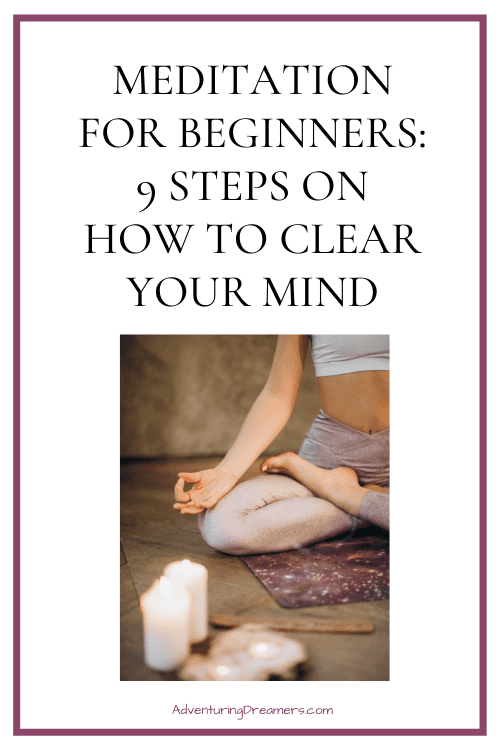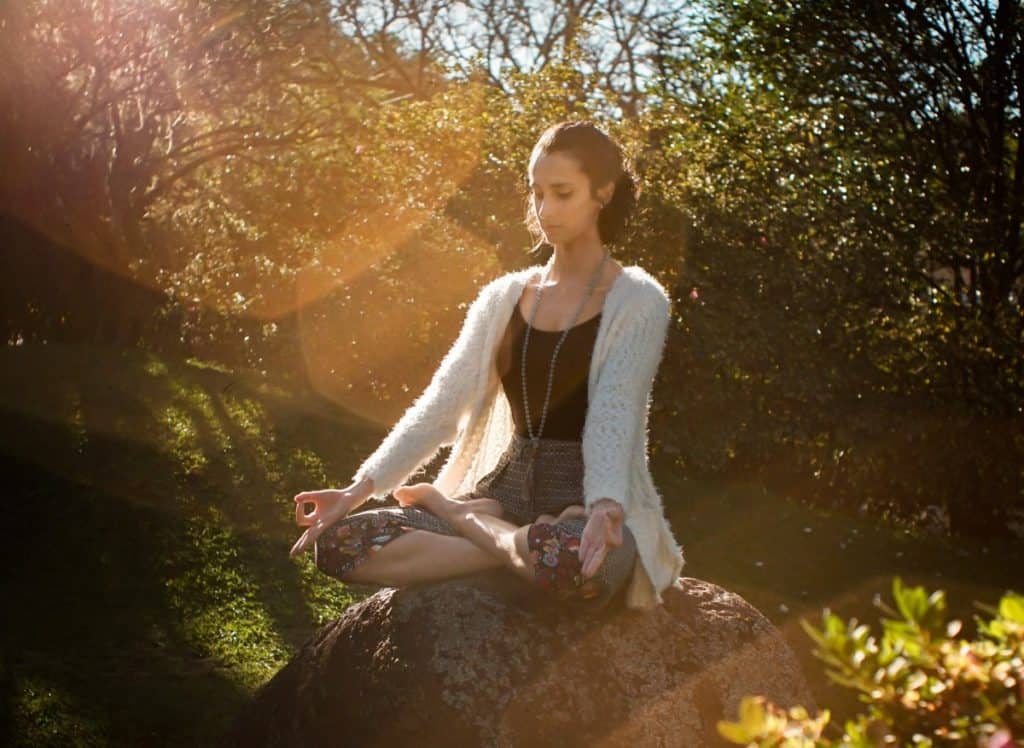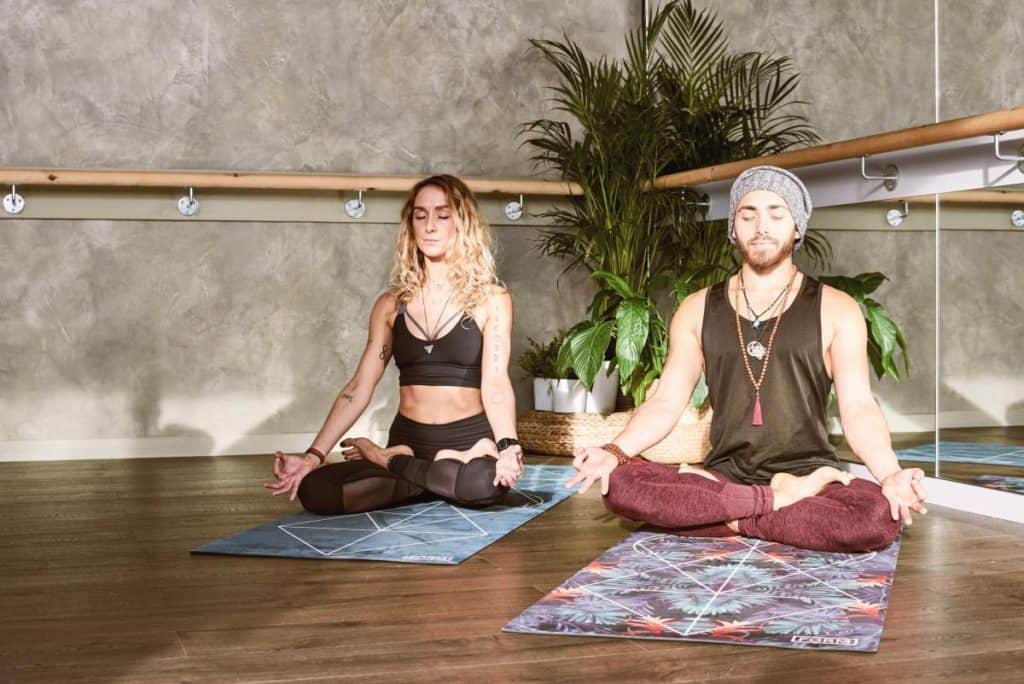Meditation for Beginners: 9 Steps on How to Clear Your Mind
In this guide to meditation for beginners, I will show you exactly how to begin your meditation practice with step-by-step instructions.

So you’re interested in meditation, huh? Congratulations! Those who practice meditation regularly often feel less stressed, more focused, and have an overall enhancement of emotional health. In fact, the health benefits of meditating range far beyond emotional well-being, but can also include lowering blood pressure, decreasing memory loss, and can help control pain.
Meditation has been practiced by cultures around the world for practically forever. While it is difficult to pinpoint exactly when humans started meditating, the earliest records of practice date back to 1500 years BCE in India. With more than 3,000 years of evidence, it is no wonder that meditation is a common practice for those who need healing and those who want to thrive at their best in mind and body.

However, if you are new to meditation, the task of quieting your thoughts and being still can seem quite impossible.
First of all, quiet your thoughts? How the heck do you learn how to stop thinking? The simple answer is, you don’t. It’s impossible to not think. In fact, if you told your brain to stop having thoughts, it would have even more thoughts reacting to the effort of not having thoughts. Try it out if you don’t believe me.
So, how do you meditate, then?
Let’s dive into this guide to meditation for beginners to find out…

Step 1: Find a quiet place.
The first step of meditation is to find somewhere where you will not be interrupted for the duration of your meditation.
Find a quiet and secluded place where you feel comfortable. This may be somewhere in your home such as your bedroom or living room. Or, it might be somewhere where you feel closer to nature, such as your backyard or a secluded area in a nearby park.
With a little practice, you can meditate pretty much anywhere. But for the meditation padawans, be sure to start somewhere where you feel comfortable and won’t get distracted.

Step 2: Sit or lie down in a comfortable position.
It doesn’t matter if you sit or lie down, as long as you are feeling comfortable.
It may be helpful to sit on a pillow to cushion your seating if you are on the floor or on a hard surface. You may also sit in a chair or rest your back against a wall or tree if you need support on your back.
Some people are more comfortable sitting cross-legged or in a half-lotus — a position with one leg crossed over the other in order to open the hips and stretch the knees and ankles. Others kneel and fold their hands in their lap.
You might feel most comfortable lying down on your bed or on a couch. I personally prefer to either lay down or sit in half-lotus. As long as you are comfortable, any position is okay.

Step 3: Determine how long you will meditate.
Have a timer with you and set it to the amount of time you wish to meditate. For a beginner, starting at five or ten minutes is ideal, then, as you get more practiced, you can begin to add a couple of minutes at a time to your sessions.
Note: if your phone is your timer, turn it on airplane mode so you don’t get distracted by notification pings, calls, or texts.
Step 4: Define your intention.
Setting an intention for your meditation is so important. Why are you meditating? Are you releasing stress or anxiety? Are you trying to find focus or clarity? Do you have a question you want to be answered? Are you looking to be connected to nature or spirituality? Are you looking to connect with yourself?
There are a hundred million reasons to meditate. Knowing your reason why helps keep you inspired so you make meditation a habit. Defining your intention also helps get the wheels turning in your subconscious. So if you are looking for clarity, your subconscious mind knows what you’re asking for and can help you find the answer.
Step 5: Close your eyes.
Did you know that eyesight is the most engaging sense? It contains two-thirds of one’s sensory cells.
While it’s possible to meditate with your eyes open, in this guide to meditation for beginners we recommend closing your eyes so you don’t get distracted by your surroundings.
They call meditation a practice for a reason. It is so easy to get distracted by thoughts, sounds, sensations, and pretty much anything and everything happening around us. Keeping your eyes closed helps eliminate at least one distraction so you can focus on the experience of the mediation instead.

Step 6: Focus on your breathing.
Don’t worry about trying to control your breathing, instead, focus on how it feels to breathe.
Breathe in. Breathe out.
Take a deep breath in and notice as the air comes in through the nose, fills up your lungs, and expands your belly and chest. Then let it go. Breathe out through your mouth and notice your body deflate as the breath leaves your body.
Pro tip: I find it extremely helpful to count as I breathe in. Notice how many seconds it takes to fill up your lungs and belly with air. Then count again as you let it go. How many seconds does it take to breathe out?
Counting takes my mind off my thoughts and allows me to focus on the present. Try this trick out and let me know how it works for you!
Step 7: Say a mantra.
If counting feels mundane, another great tip for meditation for beginners is to say a mantra.
A mantra will help to clear your mind of the noise your thoughts create. It gives your mind a focus so it doesn’t try to wander off. Pick a mantra that resonates with you and has a meaning that aligns with your meditation intention.
Some common mantras include:
- Om. Perhaps one of the most-commonly heard mantras, the om (pronounce ohm) means ‘It is, will be or will become.’
- Lumen de Lumine. It means light of light and is meant to clear the darkness from your thoughts and fill you with the feeling of light and peace.
- Love, Peace, Joy, Harmony. If any of these words speak to you, repeat one or more as your mantra and embrace their meaning with each breath.
- I feel. I exist. A mantra for presence. As you breathe in say the first part of this mantra, notice how your body feels. Notice the feel of your skin, how your hair brushes the back of your neck or the way your fingers rest on your lap. As you breathe out, imagine the universe. Imagine the sky, the trees, the grass, the ants in the dirt, and the planets beyond our own. Acknowledge the feeling of existence.

Step 8: Slowly open your eyes.
When your timer goes off, silence it and slowly open your eyes. Linger in the moment for a little longer. As you go back to your day, notice the difference in how you feel after meditating. Are you more energized? Do you feel less stressed? Are you breathing easier? Do you have the answer to your intention question if you had one?
Don’t be discouraged if you were looking for an answer to a question and one doesn’t come to you right away. Give your subconscious mind a bit more time to work through it. Your answer will come to you in divine timing.
Step 9: Repeat steps 1-8 tomorrow.
As with any other habit, repetition is key. Try to meditate at the same time every day. The more you practice, the easier meditating will become. Meditation is exercise for the mind. Just like with starting any new exercise routine, the more you do it, the more you will be able to do it and the more you will want to do it.
Other tips about meditation for beginners
- Light a candle or incense before beginning.
- Designate a space to be your meditation spot. Keep your mediation materials here such as a candle and lighter, a timer, and a pillow.
- Create a meditation playlist of relaxing music to put you in the mood. Or look up a premade list on YouTube.
- Wear comfortable clothes that don’t pinch or pull.
- Bring a journal to write down any thoughts that may come up during your meditation.
- Ask a friend or a partner to join you to raise your vibrations together.
- Find an accountability partner to hold you to daily meditation.
- Ask a question before you meditate to focus your mind.

Still having trouble clearing your mind and focusing on your breathing?
Meditation can be hard. We live in a busy world and we’re not programmed to slow down in the way meditation requires us to. If you’ve read through this entire guide to meditation for beginners and you’re still feeling antsy when you try to meditate, don’t be harsh on yourself. It’s normal. Again, meditation is a practice.
Try shaking before you meditate. Get all the jitters out of your system before sitting or laying down by shaking your body, jumping up and down, and validating your body’s need for movement. This may help you relax and sit still more comfortably.
If you’re having trouble clearing your thoughts, try a guided meditation. A guided meditation will mentor you step by step through the meditation process and will help you to use your imagination to calm your consciousness. Because in a guided meditation you are listening to someone speak, this gives your brain something to focus on other than your thoughts and can be helping finding that meditation for beginners.
Guided meditations are a great first step for novices, and are nice to go back to from time to time even once you are a practiced and independent meditator.

Additional Resources To Help You Build a More Positive Mindset
Mindset Guides:
The Complete Guide to Limiting Beliefs and How To Conquer Them
What is EFT and How to Use It to Reduce Stress
How to Lower Your Anxiety Now: 5 Easy Hacks You Can Use in the Moment
Books to Grow Your Mindset:
These are books that transformed my life and led me to where I am today and I am confident they will do the same for you.
Think and Grow Rich by Napoleon Hill
Outwitting the Devil by Napoleon Hill
The Big Leap: Conquer Your Hidden Fear and Take Life to the Next Level
The Complete Wallace D. Wattles Collection
Click Here to see more from the Adventuring Dreamers Resources.





